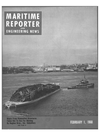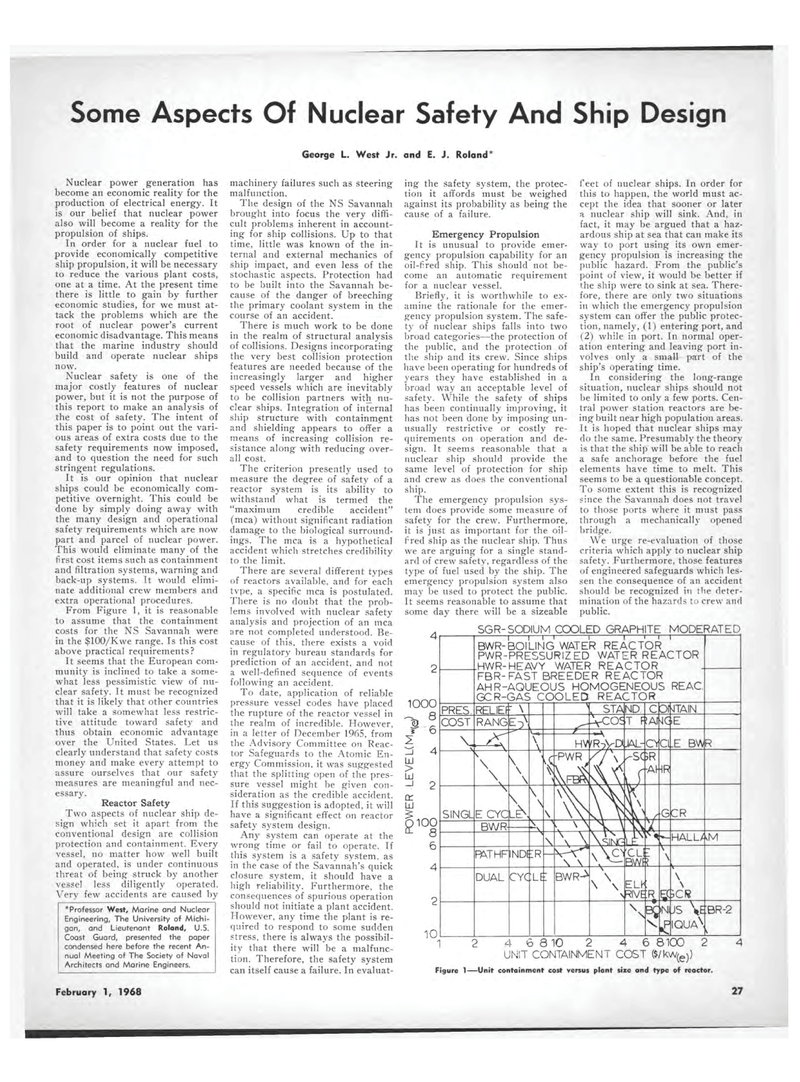
Page 25: of Maritime Reporter Magazine (February 1968)
Read this page in Pdf, Flash or Html5 edition of February 1968 Maritime Reporter Magazine
Some Aspects Of Nuclear Safety And Ship Design George L. West Jr. and E. J. Roland" Nuclear power generation has become an economic reality for the production of electrical energy. It is our belief that nuclear power also will become a reality for the propulsion of ships. In order for a nuclear fuel to provide economically competitive ship propulsion, it will be necessary to reduce the various plant costs, one at a time. At the present time there is little to gain by further economic studies, for we must at-tack the problems which are the root of nuclear power's current economic disadvantage. This means that the marine industry should build and operate nuclear ships now. Nuclear safety is one of the major costly features of nuclear power, but it is not the purpose of this report to make an analysis of the cost of safety. The intent of this paper is to point out the vari-ous areas of extra costs due to the safety requirements now imposed, and to question the need for such stringent regulations. It is our opinion that nuclear ships could be economically com-petitive overnight. This could be done by simply doing away with the many design and operational safety requirements which are now part and parcel of nuclear power. This would eliminate many of the first cost items such as containment and filtration systems, warning and back-up systems. It would elimi-nate additional crew members and extra operational procedures. From Figure 1, it is reasonable to assume that the containment costs for the NS Savannah were in the $100/Kwe range. Is this cost above practical requirements? It seems that the European com-munity is inclined to take a some-what less pessimistic view of nu-clear safety. It must be recognized that it is likely that other countries will take a somewhat less restric-tive attitude toward safety and thus obtain economic advantage over the United States. Let us clearly understand that safety costs money and make every attempt to assure ourselves that our safety measures are meaningful and nec-essary. Reactor Safety Two aspects of nuclear ship de-sign which set it apart from the conventional design are collision protection and containment. Every vessel, no matter how well built and operated, is under continuous threat of being struck by another vessel less diligently operated. Very few accidents are caused by *Professor West, Marine and Nuclear Engineering, The University of Michi-gan, and Lieutenant Roland, U.S. Coast Guard, presented the paper condensed here before the recent An-nual Meeting of The Society of Naval Architects and Marine Engineers. machinery failures such as steering malfunction. The design of the NS Savannah brought into focus the very diffi-cult problems inherent in account-ing for ship collisions. Up to that time, little was known of the in-ternal and external mechanics of ship impact, and even less of the stochastic aspects. Protection had to be built into the Savannah be-cause of the danger of breeching the primary coolant system in the course of an accident. There is much work to be done in the realm of structural analysis of collisions. Designs incorporating the very best collision protection features are needed because of the increasingly larger and higher speed vessels which are inevitably to be collision partners with nu-clear ships. Integration of internal ship structure with containment and shielding appears to offer a means of increasing collision re-sistance along with reducing over-all cost. The criterion presently used to measure the degree of safety of a reactor system is its ability to withstand what is termed the "maximum credible accident" (mca) without significant radiation damage to the biological surround-ings. The mca is a hypothetical accident which stretches credibility to the limit. There are several different types of reactors available, and for each tvpe, a specific mca is postulated. There is no doubt that the prob-lems involved with nuclear safety analysis and projection of an mca are not completed understood. Be-cause of this, there exists a void in regulatory bureau standards for prediction of an accident, and not a well-defined sequence of events following an accident. To date, application of reliable pressure vessel codes have placed the rupture of the reactor vessel in the realm of incredible. However, in a letter of December 1965, from the Advisory Committee on "Reac-tor Safeguards to the Atomic En-ergy Commission, it was suggested that the splitting open of the pres-sure vessel might be given con-sideration as the credible accident. If this suggestion is adopted, it will have a significant effect on reactor safety system design. Any system can operate at the wrong time or fail to operate. If this system is a safety system, as in the case of the Savannah's quick closure system, it should have a high reliability. Furthermore, the consequences of spurious operation should not initiate a plant accident. However, any time the plant is re-quired to respond to some sudden stress, there is always the possibil-ity that there will be a malfunc-tion. Therefore, the safety system can itself cause a failure. In evaluat-ing the safety system, the protec-tion it affords must be weighed against its probability as being the cause of a failure. Emergency Propulsion It is unusual to provide emer-gency propulsion capability for an oil-fired ship. This should not be-come an automatic requirement for a nuclear vessel. Briefly, it is worthwhile to ex-amine the rationale for the emer-gency propulsion system. The safe-ty of nuclear ships falls into two broad categories?the protection of the public, and the protection of the ship and its crew. Since ships have been operating for hundreds of years they have established in a broad way an acceptable level of safety. While the safety of ships has been continually improving, it has not been done by imposing un-usually restrictive or costly re-quirements on operation and de-sign. It seems reasonable that a nuclear ship should provide the same level of protection for ship and crew as does the conventional ship. The emergency propulsion sys-tem does provide some measure of safety for the crew. Furthermore, it is just as important for the oil-f red ship as the nuclear ship. Thus we are arguing for a single stand-ard of crew safety, regardless of the type of fuel used by the ship. The emergency propulsion system also may be used to protect the public. It seems reasonable to assume that some day there will be a sizeable feet of nuclear ships. In order for this to happen, the world must ac-cept the idea that sooner or later a nuclear ship will sink. And, in fact, it may be argued that a haz-ardous ship at sea that can make its way to port using its own emer-gency propulsion is increasing the public hazard. From the public's point of view, it would be better if the ship were to sink at sea. There-fore, there are only two situations in which the emergency propulsion system can offer the public protec-tion, namely, (1) entering port, and (2) while in port. In normal oper-ation entering and leaving port in-volves only a small part of the ship's operating time. In considering the long-range situation, nuclear ships should not be limited to only a few ports. Cen-tral power station reactors are be-ing built near high population areas. It is hoped that nuclear ships may do the same. Presumably the theory is that the ship will be able to reach a safe anchorage before the fuel elements have time to melt. This seems to be a questionable concept. To some extent this is recognized since the Savannah does not travel to those ports where it must pass through a mechanically opened bridge. We urge re-evaluation of those criteria which apply to nuclear ship safety. Furthermore, those features of engineered safeguards which les-sen the consequence of an accident should be recognized in the deter-mination of the hazards to crew and public. 1000 a LLI > LU SGR-SODIUM POOLED GRAPHITE MODERATED BWR-BOILING WATER REACTOR PWR-PRESSURIZED WATER REACTOR .HWR-HEAVY WATER REACTOR FBR- FAST BREEDER REACTOR AHR-AQUEOUS HOMOGENEOUS REAC. GCR-GAS COOLED REACTOR QL LlI £ 2 100 6 810 2 4 6 8100 2 UNIT CONTAINMENT COST ($/kw(e)) Figure 1?Unit containment cost versus plant size and type of reactor. February 1, 1968 27

 24
24

 26
26
